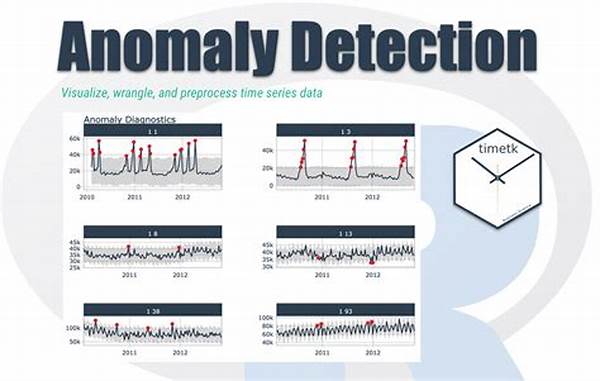Hey there, fellow data enthusiasts! Today, we’re diving into the fascinating world of time series anomaly detection methods. If you’re like me and you love finding those odd moments in a sea of data, then this is the place for you. Whether you’re a seasoned data analyst or a curious newcomer, understanding how to spot anomalies in time series data can be quite the game-changer. Let’s unpack some methods, shall we?
Understanding Time Series Anomalies
Alright, so let’s get into it! Time series anomaly detection methods are all about spotting those pesky outliers that just don’t fit the pattern. Imagine you’ve got a year’s worth of sales data, and suddenly there’s a spike. Is it because everyone’s buying that latest must-have gadget, or was there a system glitch? That’s where these methods come in, helping us to figure it all out.
The coolest part? There are loads of techniques out there, from simple statistical methods to more sophisticated machine learning approaches. You can opt for something straightforward like moving averages to pinpoint seasonal trends or venture into the exciting world of neural networks for more complex patterns. The choice of time series anomaly detection methods really depends on the complexity of your data and what you’re trying to uncover.
When you get down to using these methods, you’ll find that each has its own strengths and quirks. Some are perfect for real-time monitoring, while others are better for off-line analysis. The real trick is knowing when and where to apply each one effectively. Time series anomaly detection methods are like a toolkit — you pick the right tool for the job. And, voila! You’ve uncovered hidden insights in your data.
Key Techniques in Anomaly Detection
1. Statistical Methods: These are classic time series anomaly detection methods that use historical data to set thresholds for what’s normal. When data points stray too far, bingo! You’ve got an anomaly.
2. Machine Learning Approaches: With algorithms like k-means or random forests, you can train models to recognize anomalies. They’re great for handling complex datasets where patterns aren’t immediately obvious.
3. Neural Networks: These are the big guns in time series anomaly detection methods. With neural networks, you can capture intricate patterns and detect anomalies, even in highly dynamic data environments.
4. Seasonal Decomposition: By breaking down data into trend, seasonality, and residual components, this method helps identify anomalies by focusing on unusual residuals.
5. Hybrid Models: Why choose one when you can combine them? Hybrid time series anomaly detection methods like combining statistical techniques with machine learning offer the best of both worlds.
Real-World Applications
Now, let’s chat about how these time series anomaly detection methods are put to use in the real world. Think about financial markets, where sudden drops or surges in stock prices need to be explained quickly. Here, these methods help traders and analysts separate market noise from real trading opportunities.
Then, there’s the realm of IT and network security. With the right time series anomaly detection methods in place, you can spot a cyber attack as it unfolds, which is just about as important as it gets. Knowing how to swiftly respond to such anomalies can mean saving huge amounts of data from a breach.
And don’t forget healthcare! Time series anomaly detection methods are vital for patient monitoring systems. Detecting abnormal patterns in a patient’s heart rate, for example, could mean the difference between life and death. Yep, this stuff really is that important.
Time Series Anomalies: An In-Depth Look
Diving a bit deeper, we can see these time series anomaly detection methods in action through numerous examples. Let’s talk infrastructure monitoring. A sudden spike in resource usage could indicate a looming server crash. Preempting these anomalies with methodical detection can save both money and frustration.
The energy sector loves time series anomaly detection methods too. It helps in forecasting demand and spotting odd consumption patterns. Say goodbye to mysterious spikes in your electricity bill when you leverage these insights right.
Retailers, raise your hands! Time series anomaly detection methods can forecast potential inventory mishaps. Before a product unexpectedly runs out during a big sale, these methods give a heads-up to reorder and keep customers happy.
Diving Into the Data Stream
When it comes to real-time data, time series anomaly detection methods can truly shine. With the rise of IoT devices, data streams continuously. Catching anomalies in these streams means you can react instantly. Whether it’s adjusting manufacturing processes or improving user experiences, the power to act swiftly is revolutionary.
And then there’s social media analytics. Identifying unusual trends or spikes in mentions about a brand or product could unveil PR opportunities or brewing consumer dissent. With time series anomaly detection methods, businesses can ride the wave of social buzz more effectively.
The Wrap-Up on Anomaly Detection
To sum it all up, time series anomaly detection methods are like the superheroes of the data world. Whether you’re saving server clusters from crashing, preventing financial disasters, or simply trying to keep up with consumer trends, these methods offer a crucial edge. Their application is wide, their impact substantial, and their ability to shine a light on the shadows of data is, quite frankly, amazing.
Next time you’re sifting through time series data, remember the arsenal of time series anomaly detection methods at your disposal. They’re here to guide you through the noise, help make sense of chaos, and maybe, just maybe, make you feel a bit like a data detective. So, get out there, embrace the anomalies, and make data-driven decisions with confidence!

